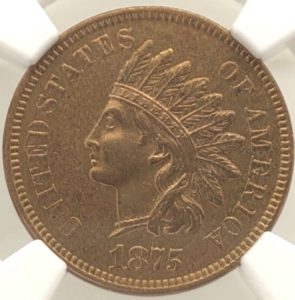Indian Cents
With its high relief design, the Flying Eagle cent was difficult to strike. Owing also to its unpopularity, Mint Engraver James B. Longacre was asked for redesigns and the eventual winner was the Indian Head obverse and laurel wreath reverse combination. It is said that Mint Director James Ross Snowden preferred the design, known as Indian Head design, because it had the lowest relief and would therefore be easy to strike.
History of the Indian Cent
Before the Indian Head figure was chosen, several patterns were created by Longacre and Anthony C. Paquet. A lot of the designs were simply  enhancements of the Flying Eagle design, the changes added to make the coin easier to strike. Many of these designs were sold to collectors.
enhancements of the Flying Eagle design, the changes added to make the coin easier to strike. Many of these designs were sold to collectors.
Snowden even suggested the use of Christopher Columbus’ head for the one-cent coin, but Longacre dismissed the idea as he believed the public won’t want a historic figure on a coin. The Mint Director eventually settled on the figure of an Indian girl wearing a feathered headdress, with the design going into production in January 1859.
The Indian Head one-cent coin was produced for 50 years, to be replaced by the Lincoln cent that continues to be used today.
Design of the Indian Cent
Simple is the best way to describe the Indian Cent. The obverse features a portrait of an Indian girl while the reverse featured a laurel wreath. The figure in the obverse is accompanied by only the date and the words UNITED STATES OF AMERICA. Apart from the wreath, only the value of the coin ONE CENT is found on the reverse.
Many think that the Indian girl in the coin is modeled after Longacre’s daughter, Sarah. Evidence proves otherwise as the same design is found in his sketchbooks dating 10 years earlier. Longacre himself referred to the figure as the “Crouching Venus,” a Greco-Roman statue that was displayed in a Philadelphia Museum.
The Indian Head coin was received well on its release. Its circulation in 1860 was also momentous, with the year being the eve of the American Civil War. The coin’s reverse even features a small federal shield on top of its value.
Variations of the Indian Cent
Indian Cents were made using different metals throughout its run. Indian Head cents from 1859 to 1864 were all copper-nickel and minted in Philadelphia. Proofs were also made annually during those years. This particular series doesn’t have standout rarities, except for the 1860 Indian Cent with a pointed bust.
The coin was hoarded during the war and as such, the Mint switched to using bronze, the metal used from 1864 to its last run in 1909. Although some copper-nickel cents were also produced, but bronze coins had higher mintage.
The bronze Indian cent has a rarity: the initial L in the ribbon of the Indian’s bonnet in the 1864 Indian Head coin.
Bronze Indian Cents were produced until 1909, when it was replaced with the Abraham Lincoln design. The Indian Head design also remained untouched, except for little changes made by Chief Engraver Charles Barber in 1886.
Indian Cents were mostly struck in Philadelphia, with the exception of 1908 and 1909 when the San Francisco mint struck a few quantities, with their coins featuring an “S” mintmark.
